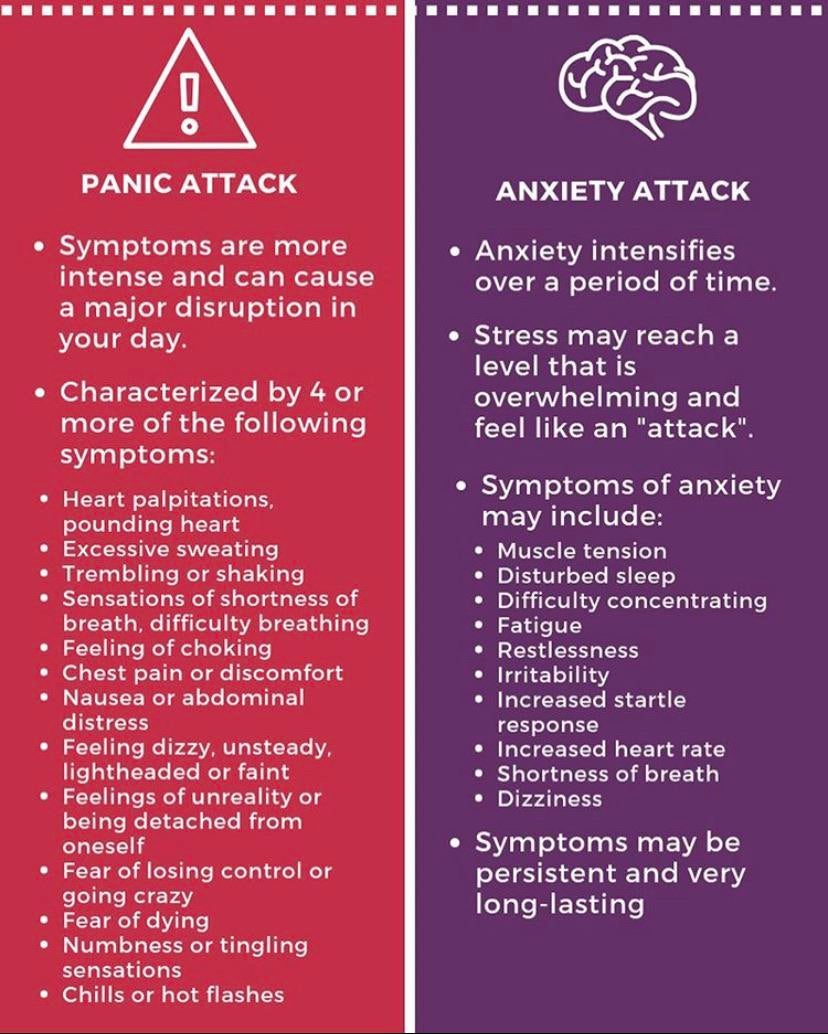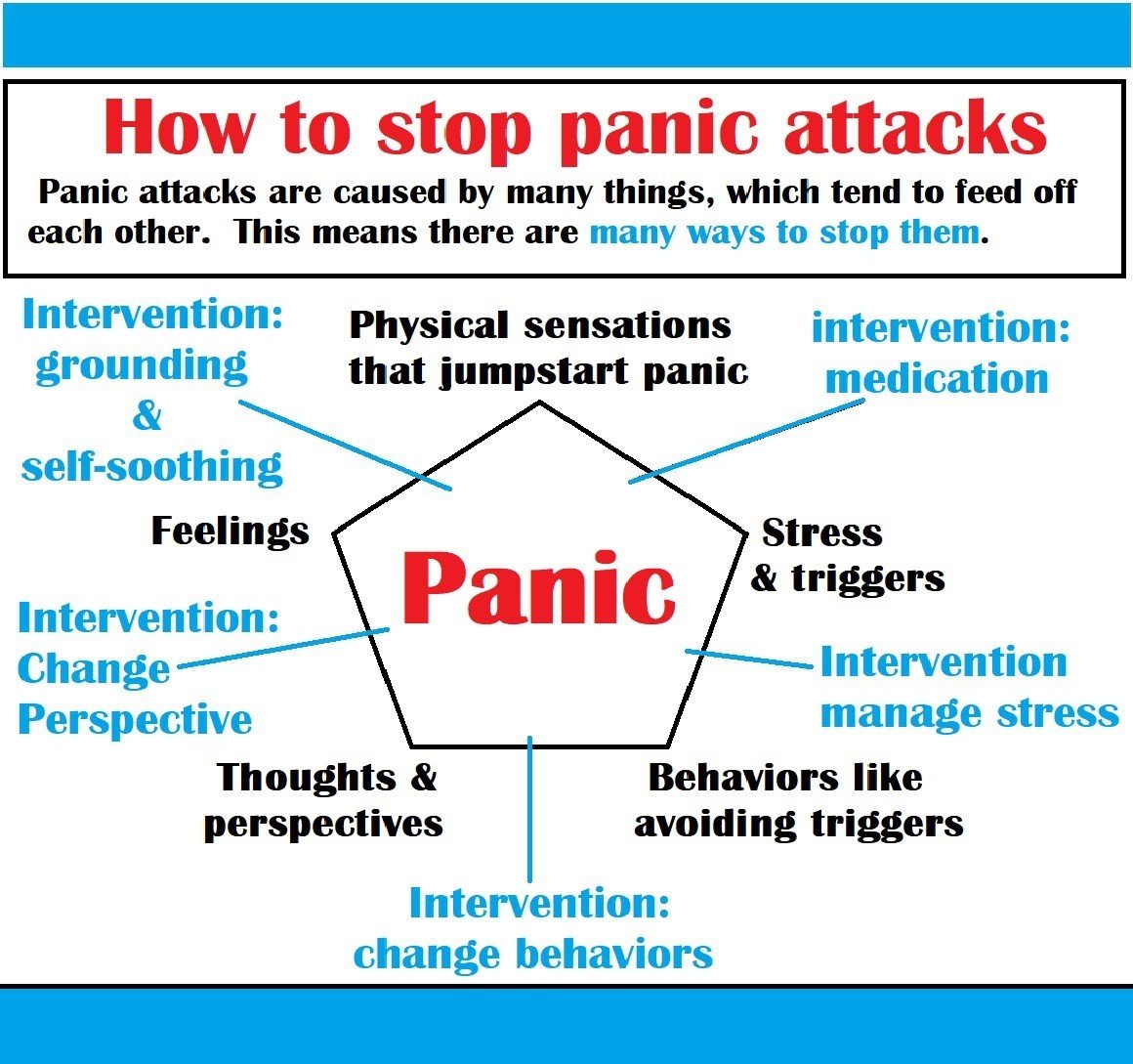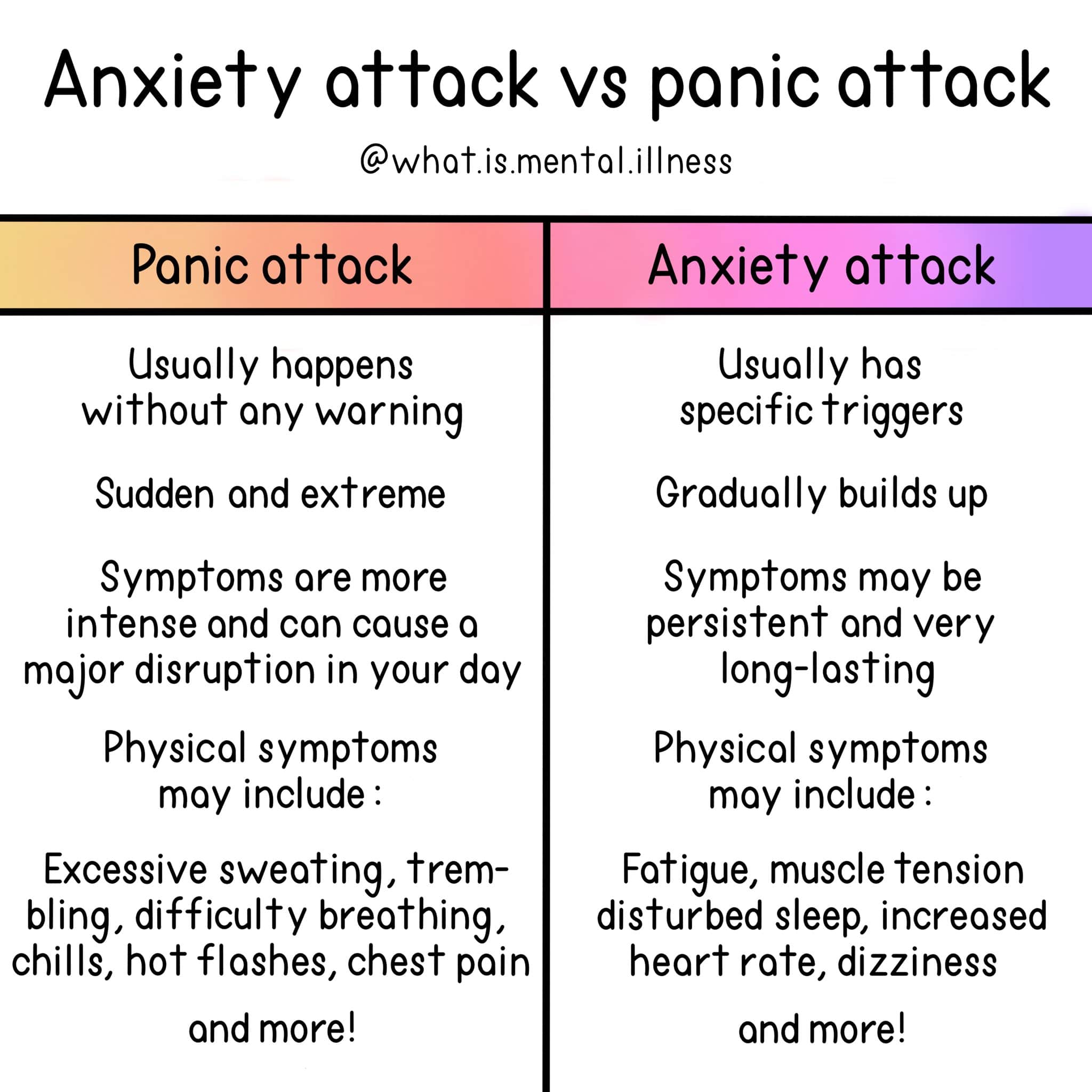How To Deal With Panic Attacks
A panic attack is a feeling of sudden and intense anxiety.
Panic attacks can also have physical symptoms, including shaking, feeling disorientated, nausea, rapid, irregular heartbeats, dry mouth, breathlessness, sweating and dizziness.
The symptoms of a panic attack are not dangerous, but can be very frightening.
They can make you feel as though you are having a heart attack, or that you are going to collapse or even die.
Most panic attacks last somewhere from five minutes to half an hour.
What Are The Signs Of A Panic Attack
Panic attacks can happen quite quickly and at any time. A panic attack can last anywhere from a few minutes to half an hour. During the attack, people can feel totally overwhelmed and disabled. Symptoms include:
- intense and overwhelming feelings of panic or fear
- increased heart rate
- dizziness, light-headedness or numbness in hands, arms or feet
- feeling like youre dying, choking, or losing control
- feeling detached from your surroundings, or that the world around you isnt real.
Treatment For Anxiety Attacks
If youre suffering from anxiety attacks, help is available. Often, treatment for anxiety attacks may include therapy, medication, or a combination of the two2.
Cognitive behavioral therapy and exposure therapy may be helpful in treating anxiety disorders and anxiety attacks. Depending on your symptoms, a doctor may also prescribe antidepressant medication.
Also Check: Who Diagnoses Anxiety And Depression
What Are The Signs And Symptoms Of Panic Disorder
People with panic disorder may have:
- Sudden and repeated panic attacks of overwhelming anxiety and fear
- A feeling of being out of control, or a fear of death or impending doom during a panic attack
- An intense worry about when the next panic attack will happen
- A fear or avoidance of places where panic attacks have occurred in the past
- Physical symptoms during a panic attack, such as:
- Pounding or racing heart
- Stomach pain or nausea
Hunger And Panic Attacks

Panic and anxiety attacks can be really scary experiences, and in a lot of people hunger and hypoglycemia can be big contributing factors to an episode.
A panic attack is essentially the body activating its emergency response system. Mechanically, your blood is pumped full of adrenaline so that it will have the energy it needs to act while your brain decides whether to fight, flee, or freeze. It also increases your heart rate, worry, can cause excessive sweating, and can cause many other uncomfortable symptoms of stress.
When experienced outside of an actual emergency situation, this can be terrifying, increasing the feelings of fear and anxiety that led up to the attack in the first place and creating a kind of feedback loop that can feel like the end of the world.
Panic attacks may feel different for different people who experience them. In some people, they manifest as a tremendous increase in uncontrolled energy.
Other people may experience the opposite, where they feel like they cant move their body from a certain spot. This is partially a result of the individuals bodys preferred response to danger, whether its fighting, running away, or playing dead. That being said, freezing responses are fairly uncommon in most people.
Anxiety attacks often describe a less severe version of the same kind of event.
Involuntary panic attacks are caused by things that are out of our control. Chronic stress and hyperstimulation are both common causes of involuntary panic attacks.
You May Like: How Do You Know If You Have Anxiety
When To Seek Professional Help
There are some coping strategies that can be effective if a persons worries, fears, or anxiety attacks are not too severe. For instance, some people find that writing down their worries helps. Meanwhile, others allow themselves a set amount of time to worry about something. When the time is up, they force themselves to think about other things. Other options include practicing relaxation techniques, exercise, meditation, and prayer.
But when the worries, fears or anxiety issues are significant enough that they are disrupting a persons life in some way, it is important to seek professional help.
Sometimes, physical anxiety symptoms like irregular heartbeats, sweating or persistent anxiety will be related to a medical condition instead of an anxiety disorder. Some possible culprits could be thyroid issues, hypoglycemia or even mitral valve prolapse.
Whats more, certain medications or herbal remedies could cause symptoms as well. Be sure to consult a doctor for any lingering physical symptoms especially irregular heartbeats or breathing difficulties.
Preventing A Further Attack
It may help to:
- read a self-help book for anxiety based on the principles of cognitive behavioural therapy ask your GP to recommend one
- try complementary therapies such as massage and aromatherapy, or activities like yoga and pilates, to help you relax
- learn breathing techniques to help ease symptoms
- do regular physical exercise to reduce stress and tension
- avoid sugary food and drinks, caffeine and alcohol, and stop smoking, as all they can all make attacks worse
For more help, read how to deal with panic attacks.
Recommended Reading: What Can Calm My Anxiety
Anxiety And Panic Attacks
Explains anxiety and panic attacks, including possible causes and how you can access treatment and support. Includes tips for helping yourself, and guidance for friends and family.
Mae’r dudalen hon hefyd ar gael yn Gymraeg. This link will take you to a Welsh translation of this page.
Talking To A Health Care Provider About Your Mental Health
Communicating well with a health care provider can improve your care and help you both make good choices about your health. Find tips to help prepare for and get the most out of your visit at Taking Control of Your Mental Health: Tips for Talking With Your Health Care Provider. For additional resources, including questions to ask a provider, visit the Agency for Healthcare Research and Quality website.
If you or someone you know is in immediate distress or is thinking about hurting themselves,call the National Suicide Prevention Lifeline toll-free at 1-800-273-TALK . You also can text the Crisis Text Line or use the Lifeline Chat on the National Suicide Prevention Lifeline website.
Recommended Reading: How To Fix Separation Anxiety
Treatment For Panic Attacks And Panic Disorder
The most effective form of professional treatment for tackling panic attacks, panic disorder, and agoraphobia is therapy. Even a short course of treatment can help.
Cognitive behavioral therapy focuses on the thinking patterns and behaviors that are sustaining or triggering your panic attacks and helps you look at your fears in a more realistic light. For example, if you had a panic attack while driving, what is the worst thing that would really happen? While you might have to pull over to the side of the road, you are not likely to crash your car or have a heart attack. Once you learn that nothing truly disastrous is going to happen, the experience of panic becomes less terrifying.
Exposure therapy for panic disorder allows you to experience the physical sensations of panic in a safe and controlled environment, giving you the opportunity to learn healthier ways of coping. You may be asked to hyperventilate, shake your head from side to side, or hold your breath. These different exercises cause sensations similar to the symptoms of panic. With each exposure, you become less afraid of these internal bodily sensations and feel a greater sense of control over your panic.
Prevalence Of Panic Disorder
Panic disorder affects 2-3% of people every year in the United States and Europe, with varying rates depending on race and ethnicity. On average, Native American Indian populations experience panic disorder at higher rates than non-Latino white Americans. In contrast, African Americans, Latinos, Caribbean Blacks, and Asian Americans all experience the disorder at lower rates than non-Latino white Americans. In addition, it has been well established than females are twice as likely to be diagnosed with panic disorder than males . A number of factors have been identified as possibly influencing sex differences in rates of panic disorder . However, no one theory has been determined so the underlying reason for sex differences in rates of panic disorder remains unknown.
The typical course of panic disorder begins in adolescence and peaks in early to mid-twenties, with symptoms rarely present in children under the age of 14 or in older adults over the age of 64 . Caregivers can look for symptoms of panic attacks in adolescents, followed by notable changes in their behavior , to help potentially identify the onset of panic disorder. Panic disorder is most likely to develop between the ages of 20-24 years and although females are more likely to have panic disorder, there are no significant sex differences in how the disorder presents .
Read Also: Does Anxiety Cause Blurry Vision
Don’t Miss: How To Get Rid Of Stress Anxiety And Depression
Panic Attack Vs Anxiety Attack: Whats The Difference
Although the term anxiety attack and panic attack are sometimes used interchangeably, panic attacks are a clinically recognized symptom of panic and anxiety disorders. Typically, when people use these terms in a casual way, they use anxiety attack for low to moderate episodes of fear and panic attack for more severe episodes.
What Are Panic Attacks And Panic Disorder

A panic attack is a sudden, intense fear or anxiety. It may make you short of breath or dizzy or make your heart pound. You may feel out of control. Some people believe that they’re having a heart attack or are about to die. An attack usually lasts from 5 to 20 minutes. But it may last longer, up to a few hours. If these attacks happen often, they are called a panic disorder.
Panic attacks can be scary and so bad that they get in the way of your daily activities. Treatment can help most people have fewer symptoms or even stop the attacks.
Don’t Miss: How To Stop Driving Anxiety
Recognizing The Signs Of A Panic Attack
Now that we know some of the primary causes of panic attacks, we will now understand how to recognize the signs of a panic attack. If you observe these signs in yourself or see someone going through them, it might be an indication of a panic attack. Some of the most common tell-all signs of a panic attack include:
- Feelings of unreality or derealization
- Dizziness or lightheadedness
- Feelings of unreality or derealization
- Fear of losing control or going crazy
If you are experiencing any of these symptoms, it is important to seek help. Panic attacks can be very debilitating and can interfere with your ability to live a normal life. It is important to be able to recognize the signs of a panic attack so that you can seek treatment if necessary.
Panic Disorder In Children
Panic disorder is more common in teenagers than in younger children.
Panic attacks can be particularly hard for children and young people to deal with. Severe panic disorder may affect their development and learning.
If your child has the signs and symptoms of panic disorder, they should see a GP.
After taking a detailed medical history the GP will carry out a thorough physical examination to rule out any physical causes for the symptoms.
They may refer your child to a specialist for further assessment and treatment. The specialist may recommend a course of CBT for your child.
Screening for other anxiety disorders may also be needed to help find the cause of your child’s panic attacks.
You May Like: How To Overcome Anxiety Naturally
How Are Panic Attacks Diagnosed
Serious health problems, such as heart disease, thyroid disease and respiratory problems, cause symptoms similar to panic attacks. Your healthcare provider may run tests to rule out a physical problem. If theres no physical cause, your provider may make a diagnosis based on your symptoms and risk factors.
Overview
High cholesterol can increase your chance of heart attack and stroke. Stress can do that as well. Some research shows a possible link between stress and cholesterol.
Cholesterol is a fatty substance found in some foods and also produced by your body. The cholesterol content of food is not as noteworthy as the trans fats and saturated fats in our diets. These fats are what can cause the body to make more cholesterol.
There are so-called good and bad cholesterols. Your ideal levels are:
- LDL cholesterol: less than 100 mg/dL
- HDL cholesterol: more than 60 mg/dL
- total cholesterol: less than 200 mg/dL
When bad cholesterol is too high, it can build up in your arteries. This affects how blood flows to your brain and your heart, which could cause stroke or heart attack.
Risk factors for high cholesterol include:
- family history of high cholesterol, heart problems, or strokes
- smoking tobacco
Pregnancy And Postpartum Hormonal Changes
The hormonal changes that occur during pregnancy and after childbirth can trigger panic attacks. This is because these hormones can cause changes in the brain that make it difficult to cope with stress. It also happens because pregnancy and postpartum can be stressful life events that can lead to changes in routine, which can be difficult for the mind and body to adjust to.
You May Like: How Do I Calm My Anxiety
How Can You Tell That Youre Having An Anxiety Attack
Sometimes anxiety attacks come on slowly, over the course of a few days. Other times, they seem to come on suddenly, as if out of the blue. Both types of experiences are common. Anxiety attacks arent just emotional or mental: they often involve some telltale physical symptoms as well.
Here are some common signs and symptoms of anxiety attacks:
- Rapid heartbeat
Anxiety What Is Anxiety Signs Causes Symptom
Recommended Reading: Type 2 Diabetes And Anxiety
Don’t Miss: How To Get Rid Of Anxiety Stomach Aches
What You Need To Know About Panic Disorders
Unlike anxiety, which often has clear triggers, panic attacks occur suddenly and unexpectedly and typically only last for a few minutes.
Those who experience panic attacks have reported lightheadedness, chest pain, hot flashes, chills, and stomach discomfort. Some say they feel like they were being choked or suffocated. Others say an attack made them feel detached from reality.
Occasional panic attacks can happen to anyone, although for some individuals, they occur more frequently and cause significant distress and impairment.
Evidence-based treatments for panic disorder are similar to those for anxiety and involve exposure-based treatment. Mindfulness and meditation can also be useful to curb stress and promote increased psychological flexibility.
Sometimes medications are used to augment behavioral treatments for panic disorder and include beta-blockers, selective serotonin reuptake inhibitors, and serotonin-norepinephrine reuptake inhibitors.
If you have had continued panic attacks, you may need to seek professional help. Your doctor will ask about your symptoms, other mental health and medical conditions, and whether you are experiencing abnormal stress or anxiety. Blood tests and a heart examination may also be required.
Both panic and anxiety are treatable and manageableeven when they may feel as if they are out of your control.
What Causes Panic Disorder

You may wonder if there is one specific cause of panic disorder. Was there an event you witnessed? A genetic trait you have? Did past circumstances lead you here?
You might say that anxiety causes panic disorder. But its not that straightforward. In fact, many people who experience panic attacks dont develop panic disorder.
As with many mental health conditions, the root causes of panic disorder are not well understood yet.
Many factors may come into play. In some rare cases, underlying medical conditions can also explain the condition.
Its important to have a complete medical examination. What may appear to be panic disorder could be a medical illness, such as thyroid or other hormonal diseases, cardiac disorder, seizures or other illnesses that present themselves as panic disorder, says Beresin.
Once an underlying medical condition has been ruled out, other contributing factors are taken into consideration, including:
- presence of other mental health conditions
Recommended Reading: How To Fix Separation Anxiety In Puppies
How Are Panic Attacks Managed Or Treated
Psychotherapy, medications or a combination are very effective at stopping panic attacks. How long youll need treatment depends on the severity of your problem and how well you respond to treatment. Options include:
- Psychotherapy:Cognitive behavioral therapy is a type of psychotherapy, or talk therapy. You discuss your thoughts and emotions with a mental health professional, such as a licensed counselor or psychologist. This specialist helps identify panic attack triggers so you can change your thinking, behaviors and reactions. As you start to respond differently to triggers, the attacks decrease and ultimately stop.
- Antidepressants: Certain antidepressant medications can make panic attacks less frequent or less severe. Providers may prescribe serotonin selective reuptake inhibitors , serotonin-norepinephrine reuptake inhibitors or tricyclic antidepressants . SSRIs include fluoxetine and paroxetine . SNRIs include duloxetine and venlafaxine . TCAs include amitriptyline and doxepin .
- Anti-anxiety medications: Benzodiazepines are the most commonly prescribed anti-anxiety medication to treat and prevent panic attacks. They help with anxiety but have risks of addiction or dependence. These medications include alprazolam and lorazepam .